Signs That You Might Need Braces
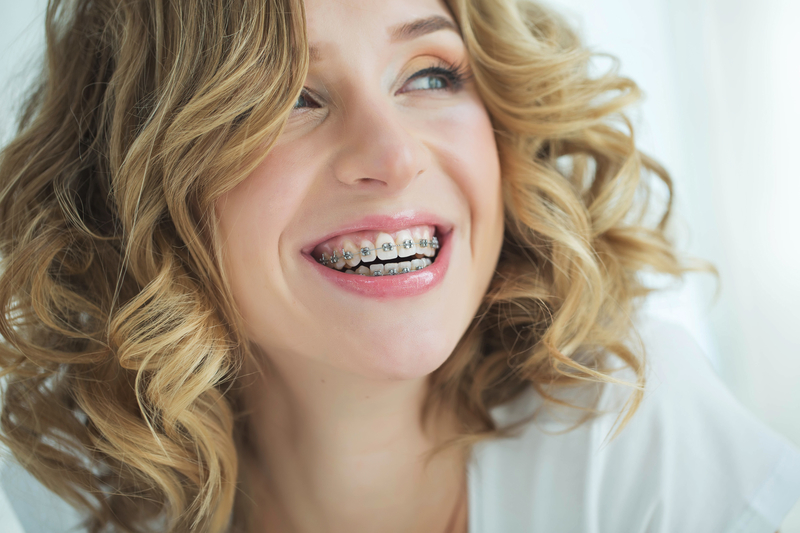
For many patients, getting braces is a big decision that affects oral health. How do you know whether you or your child needs braces, though? Some symptoms are obvious: misplaced or crowded teeth, or teeth that don’t meet normally. Other signs that you need braces are more inconspicuous, though, such as biting the cheek or a jaw that pops or shifts. While some of these symptoms are more serious than others, orthodontic care is the way to go to alleviate pain and correct any underlying issues. Learn about what signs you should be looking for to decide if braces are right for you with these tips!
What To Look Out For
As our teeth begin to erupt at a young age, they can fill into improper spaces or cause problems with adjacent teeth. Crooked or misaligned teeth aesthetically aren’t very pleasing for people, and most patients end up receiving orthodontic treatment during some point in their lives. Orthodontic problems don’t always mean crooked teeth, though. While there are some obvious signs that you might benefit from orthodontics, such as crowded teeth or an underbite/overbite, there are other symptoms that are less noticeable but equally as undesirable. The American Association of Orthodontics recommends that children have their first orthodontic visit between the ages of 7 and 8, but if certain complications are present, your child does not and should not wait until that age to be seen. If you have a young child, look for some of the following symptoms that warrant orthodontic care:
- Thumb or finger sucking
- Early, late or irregular loss of baby teeth
- Difficulty in chewing or biting
As children age, orthodontic problems will begin to show themselves, but some don’t appear until adulthood. No matter your age or prior orthodontic care, there are other symptoms that indicate a problem and should be addressed by an orthodontist. If you are struggling with a popping jaw, have to breathe through your mouth on a regular basis, are constantly biting your cheeks, and/or noticing teeth or jaws that are out of proportion to the rest of your face, you should have an orthodontic consultation. While many of these symptoms seem harmless or aren’t very noticeable, they can have long-term consequences that can negatively affect your oral health. Braces can remedy these issues so that your oral health isn’t compromised. It’s never too late for you to take charge of your oral health and get the smile that you deserve!
Advantages of Early Orthodontics
Not all kids will need orthodontic care, but many will. Meeting with your child’s dentist early on will help them determine whether your child would benefit from orthodontic treatment. If you have a child who needs an orthodontic issue remedied, there are certain advantages that come after receiving braces. Having your child evaluated by an orthodontist can help he/she observe the progress of incoming teeth, guide teeth into their ideal positions, monitor face and jaw development, detect hidden dental issues and reduce the risk of impacted teeth. For young children, orthodontic visits can sometimes be scary. Nonetheless, child orthodontic visits are simple and non-intrusive, so as to keep your child comfortable and happy. At Belmar Orthodontics, we do our best to give your child the care they need while making sure that their fears and questions are addressed. For adolescents, our options at include aesthetically-minded treatment options that will help your teen feel less self-conscious about braces. Braces can sometimes be seen as “dorky” or “uncool” for teens, but the list of options your teenager can choose from will give them plenty of choices to get straight teeth while still looking cool. Good oral health habits are started at a young age, and bringing your child in to see the orthodontist will help them establish those habits that will last a lifetime.
How You Can Benefit From Adult Orthodontics
Against popular belief, braces and orthodontic care aren’t just for kids and teenagers! In fact, one in five orthodontic patients is an adult; in just the U.S. and Canada alone, more than a million orthodontic patients are adults! You, as an adult, can benefit from the same care that young patients do and fix the orthodontic problems that you’ve been suffering from since childhood. As long as your teeth are healthy, you can receive orthodontic treatment at any age. The most common benefits of adult orthodontics include the following:
- More discreet treatment methods
- Correction of lifetime dental issues
- Faster treatment time than previous treatments
- Increased confidence and self-esteem
It’s important to note, however, that any previous orthodontic problems, such as periodontal disease or decayed/missing teeth, will need to be addressed before an orthodontic appliance can be placed. Once those issues are fixed, you’ll be fitted with braces and can continue your life just as usual. If you so choose, you can even opt in for hidden lingual braces or Invisalign clear, which will get you the straight teeth that you want while being completely unnoticeable. Speak with your orthodontist to determine which braces would be best for your needs before making any decisions.
Staying On Top Of Your Oral Health
Before any patient can receive orthodontic treatment, the health of their teeth, gums and mouth will first be evaluated. For this reason, it is important that children and adults alike are brushing twice a day and flossing on a nightly basis. The foods we eat also affects our oral health, as well. Especially during orthodontic treatment, certain foods, like sticky or sugary candies and food, can damage orthodontic appliances and make it easier for tooth decay to develop as plaque builds up on teeth. Brushing and flossing will partly diminish the effects of these foods, but not entirely. Make sure that you and your children are eating a healthy diet with minimal sugary snacks to avoid dental complications during treatment.
To ensure good oral health during and after orthodontic treatment, schedule an appointment with Belmar Orthodontics at (303) 225-9016 for a consultation.
The Impact Of Straight Teeth On Oral Health
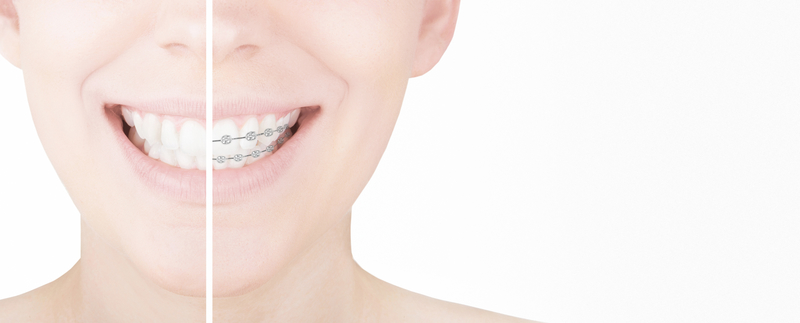
Many orthodontic patients use braces so that they can have straight teeth, but that’s not the only reason why orthodontic care is so important. Having straight teeth can minimize the likelihood of tooth decay and tooth loss while improving your bite, which affects your ability to chew and speak. Correcting crooked teeth can also improve your oral hygiene and strengthen teeth. Learn more about the positive effects that straight teeth can have on your oral health through this guide!
How Straight Teeth Can Help You
One of the main goals of braces is to create a straight smile and correct any orthodontic issues that may prevent teeth from remaining straight. While orthodontics does focus on straightening patients’ teeth, this is not the only purpose of receiving orthodontic care. Whenever a patient has malocclusion, or bad bite, caused by crowded or crooked teeth, daily oral hygiene can become a difficult task. Malocclusion can also stem from teeth that are out of alignment, or jaws that do not meet properly. Thumb sucking or accidents to the teeth can also cause malocclusion. As oral hygiene becomes more difficult to maintain, the likelihood of dental complications, such as tooth decay, periodontal disease, and tooth loss, increases. An improper bite that goes unaddressed can negatively affect chewing and speaking, and wear down tooth enamel. Correcting these problems is of utmost importance to your orthodontist as they seek to give you the best care possible. Orthodontic care that helps straighten teeth can decrease and ultimately eliminate the chances of any of these complications from arising. With straight teeth, patients can better brush and floss their teeth, which will help strengthen them, while easily monitoring any changes that may occur.
What To Expect With Orthodontics
As you begin your orthodontic treatment, there are a few tips that you should know to prepare yourself for what will be expected of you during your time with braces. Although there are some challenges with straightening adult teeth versus children’s teeth due to the pliability of the jawbone, modern technology allows any adult of any age the opportunity to correct crooked teeth with remarkable success. You will first meet with an orthodontist for an evaluation and orthodontics consultation to determine what option is best for your mouth. Any oral health issues, such as gum disease, will have to be resolved before you can begin treatment. Adults have a variety of options to choose from for their orthodontic care, with many discreet options, such as ceramic or clear braces, lingual braces, and Invisalign clear removable retainers, that are available for your needs.
For children, treatment is similar to that of adults and can start as early as the age of 7. Having an orthodontic examination early on can prevent the progression of orthodontic issues that are present and allow the orthodontist to monitor the development/eruption of teeth. Aesthetically-minded treatment options, such as incognito lingual braces, are available for young children who may be self-conscious about their orthodontic care. Most children and adults can expect treatment for 1-3 years, followed by a period of time in which a retainer will be used to keep teeth in their newly aligned positions. Regular dental and orthodontic visits will be necessary to track the progress of teeth and manage any plaque or tartar buildup that could accrue between teeth.
How To Keep Your Straight Teeth Healthy
Once you or your child finishes orthodontic treatment, it is important to continue certain oral health standards to maintain the health of your gums and teeth. Eating a healthy diet, with or without braces, while limiting the amount of sugary foods you consume, will prevent plaque that can stain or damage your teeth. Brushing with fluoride toothpaste and flossing each day will also prevent any plaque buildup, prevent cavities, and keep your teeth clean. Good oral hygiene is especially important for patients wearing braces because you are more susceptible to plaque buildup around brackets and underneath wires. For additional protection, consider using a mouth guard while playing any sports or activities that could damage your mouth, if hit. Creating a good oral health regimen before you start orthodontic treatment will help you have a healthy mouth during and once braces are removed.
For more information on the importance of straight teeth on oral health and what you can do to get the straight teeth that you want, call Belmar Orthodontics at (303) 225-9016! If you’re ready to change your smile for the better, our team is ready to help you reach that goal for you and the rest of your family!
Is It Too Late For Me To Get Braces?

Most orthodontic patients receive their braces at a young age, typically during the teenage years. Are the teenage years the best time to receive braces, or will treatment work just as well as an adult? With the technological advances that have occurred, adult orthodontics have more options than ever to straighten smiles of all ages. Some benefits of adult orthodontics include correction of life-time dental issues, faster treatment time than former technology, and increased confidence. If you’re ready to change your smile, learn how adult orthodontics can help you through these tips!
Braces Throughout The Years
Modern advances in orthodontic treatment has revolutionized how quickly children and adults alike get the healthy and straight smiles they want, and allowed people of all ages to improve their oral health, no matter their age. For many years, traditional metal brackets were the only option to straighten teeth, but as technology has advanced, a variety of aesthetic bracket systems have been developed to give you the smile you want with braces that are less noticeable and easier to maintain. Permanent braces now come in two options: metal or ceramic. Ceramic braces are matched to teeth color, making them nearly invisible during treatment. Lingual braces are also an option, which are completely disguised from others as they are attached to the back of the teeth. Removable orthodontic appliances have recently come into play as a clear plastic aligner that is used and removed as needed. These aligners are advantageous to adults because they are less visible and easier to clean and maintain, which comes in handy for those adults busy with work and family life. As the options for braces have broadened throughout the years, so has the number of adult patients being treated for braces. Technological advances in the orthodontic industry now allows for more patients, even those who have passed the prime age for orthodontic care, to change their smiles during any part of life.
Benefits of Adult Orthodontics
The American Association of Orthodontists reports that of the 4.5 million Americans that are currently receiving orthodontic care, 25% of them are adults. Although childhood is the ideal time to receive braces, adult orthodontics has become a popular option for those who couldn’t receive treatment during adolescence. Some benefits of adult orthodontics include:
- More discreet treatment methods
- Correction of lifetime dental issues
- Faster treatment time
- Increased self-esteem and confidence
Adults ultimately have more options when choosing what braces and treatment plan is best for them. Orthodontic care protects both kids and adults against tooth decay, tooth loss, gum disease, impaired speech, chewing and jaw problems. While cost is a factor, you will still need an oral evaluation and orthodontics consultation to determine your candidacy for certain procedures and treatments. For the first time, adults of any age who have otherwise healthy teeth can benefit from orthodontic treatment at any point in life.
What To Expect With Adult Orthodontics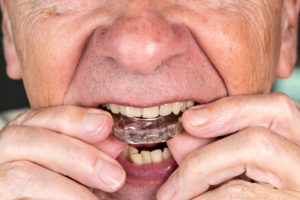
Typically, it is more difficult to manipulate an adult’s fully-developed jawbone compared to the pliable jawbone of a child, but modern-day advances now allow orthodontists to correct crooked teeth with great success and precision. Any oral health issues, such as periodontal (gum) disease, will have to be resolved before teeth can be straightened, so meeting with your dentist and orthodontist will be an important first step to take before treatment can begin. If you’re considering orthodontic treatment to correct any cosmetic or bite issues, consider the following:
- The entire process may take longer for an adult than a child. Typical treatment time averages two years, but varies from person to person.
- Fully-developed bones in adults have stopped growing, so some structural changes cannot be achieved without surgery.
- Adults may need to see a periodontist, as well as a dentist and orthodontist, to ensure that treatment will not be complicated by bone loss due to gum disease.
Adults who have had teeth removed in the past might have difficulties with orthodontic care as old extraction sites might not be suitable for teeth to move into. Adult patients receiving treatment also have a higher risk for root absorption than children do as their bodies reabsorb the root of the tooth, leaving no room for anchorage. This process causes teeth to loosen and fall out over time due to gum instability. Since braces and other appliances are cemented directly to the teeth themselves, it is important that all patients, even adults, maintain good oral health practices that will prevent the areas around the brackets from developing plaque and tooth decay, which will ensure that they get the best (and healthiest) smile possible.
Schedule An Appointment Today
If you are interested in adult orthodontics or are wanting to improve the look of your smile, call Belmar Orthodontics at (303) 225-9016 for a consultation to learn about which options are available for you. Our dedicated team of professionals are determined to help you get the smile that you want and improve your oral health!
Rubber Bands and Braces

Why use rubber bands with braces? Some people have them, and some people don’t need to use them at all. Along with brackets, archwires, and ligatures, rubber bands are just another part of braces. Rubber bands are extremely helpful as they help move the teeth and jaw into proper alignment. They are connected to the actual bracket and help improve your bite. If your jaw is misaligned, read on to discover how rubber bands might be the option to straighten your teeth and jaw at the same time!
Parts of Braces
Modern technology has changed the lives, and smiles, of millions of patients worldwide who have used or currently use braces. Nowadays, braces can be as inconspicuous as we want, with some brackets being attached to the backs of teeth, rather than the front, for a more aesthetic appeal. With the invention of a variety of orthodontic appliances, such as lingual braces, Invisalign, clear braces, and traditional, the patient can decide what braces fits their oral health goals the best. Along with the many types of braces we learn about, there are also other parts of braces that we aren’t as familiar with, such as “bracket,” “archwire,” “springs,” and “ligatures.” We have heard of the different components of braces, but what does an archwire do? How do springs help adjust our teeth? Depending on your needs, your orthodontist will install any of these appliances to help you get the best smile in the shortest amount of time possible.
Brackets are the square part of the braces that are directly attached to the tooth, usually through a cement that bonds it to each individual tooth. They are usually made of steel or clear ceramic, and they guide the archwire into the appropriate placement. The archwire is held by brackets and is designed to guide the movement of the teeth during treatment. They are normally made from stainless steel, but also can be made with titanium. Springs go between brackets and around the archwire and are also made of stainless steel or titanium. They function as a force that opens or closes a space between teeth. The archwire and the bracket are connected through ligatures, which are the little rubber bands that wrap around each bracket to hold the archwire in place. For adolescents, these are usually the best part about braces because they come in a variety of colors that kids can choose from, and are changed after each orthodontic visit whenever the archwire is tightened. Although ligatures are rubber bands, they are not the same thing as interarch rubber bands, which have a major impact on jaw and bite alignment.
Rubber Bands
Interarch rubber bands, commonly known as “rubber bands” or “elastics,” ensure that your child’s teeth are lining up properly. They adjust bite and jaw position, such as an overbite or underbite, and are connected to the bracket with hooks. They create a force to move the teeth in a particular direction, specifically closer together. The top and bottom tooth bracket are connected through these bands, which adjusts the position of the teeth in the mouth and the position of the jaw. These rubber bands are removed during meals as well as while cleaning your teeth and brackets. Usually, they are replaced daily because of the wear they endure and their likelihood of breaking if used for too long. When worn to adjust a misaligned bite, interarch rubber bands are typically worn at all times, except for when eating or cleaning your teeth. If the treatment is only minor, you might only have to wear the bands at night. The consistent tension on the teeth and jaw is what makes these bands effective. If a patient doesn’t wear their bands in the prescribed manner, whether it be the length of time is too short or you’re wearing more bands than normal, this can lengthen treatment time and move your teeth in an unintended way. Not every patient will have to use interarch rubber bands, but if your orthodontic prescribes you to wear them, make sure that you follow his or her directions exactly and take good care of your bands.
Do’s and Don’ts of Braces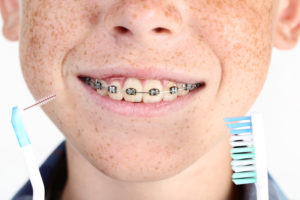
While braces have revolutionized the dental and orthodontic professions, there are some rules that a patient needs to follow to protect and get the most use out of their orthodontic appliances. Always make sure to keep your teeth clean when wearing braces. Brushing and flossing under the archwire and between the brackets is essential to remove plaque, which can easily build up on your teeth with braces. To make sure that your teeth are being cleaned entirely, replace your toothbrush every three months or as soon as the bristles are frayed. Go to all of your orthodontic appointments so that they can adjust your archwire and monitor your teeth’s movement. If you delay your adjustments, your treatment time can be increased, which can be expensive.
Even though braces are strong, you can still break a bracket or an archwire with the things that you eat. Avoid foods that can get stuck in your teeth or your braces, such as nuts, popcorn, hard candy, ice, and sticky foods like chewing gum or caramel. Try not to eat as much sugary foods as it can lead to tooth decay around the brackets, which can permanently damage your teeth. Especially for active teenagers and adults, use a mouthguard during physical activity or when playing a sport to protect your mouth and jaw from getting hurt. Following this list of do’s and don’ts will increase the likelihood of having a positive and shorter experience with braces.
Getting The Smile You Deserve
For other tips and suggestions about orthodontic appliances and which one is best for you, call Belmar Orthodontics at (303) 225-9016 for a comprehensive exam. With our team of qualified and dedicated individuals, we will provide you or your child with the best orthodontic care for a great price. Call now to learn more!
Braces With Oral Health Problems
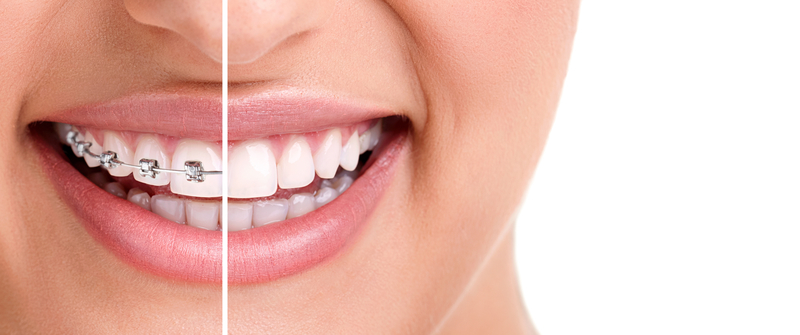
Did you know that your oral health can affect your overall health? Poor oral health can even worsen health conditions you already have such as diabetes or cardiovascular disease. That is because oral health and overall health are highly connected. Your oral issues can become better with braces, but that is only if certain oral health problems are corrected beforehand. Patients can also develop oral health problems if they don’t have the right knowledge with proper braces care. Use these tips to avoid oral health problems with braces and find out how we work around current problems to provide you with a straighter smile!
Oral Health Goals
Did you know that orthodontic treatment can give you a healthier mouth? We know that braces help straighten your teeth, but they can also improve the health of your gums and teeth. When you have crooked and crowded teeth, this makes cleaning your mouth more difficult. This can cause serious oral health problems, such as tooth decay, periodontal disease, and tooth loss. Whether you have straight or crooked teeth, before you let an orthodontist start working on you, there are some important oral health tips to be following before any work begins:
- Eat a healthy diet that limits sugary beverages and snacks
- See a dentist regularly for prevention and treatment of oral disease
- Brush teeth twice a day with fluoride toothpaste
- Floss daily
- Discuss changing certain lifestyle practices, like smoking and using oral piercings
Types of Braces
Braces are a big commitment, and you want to make sure you’re using the correct ones whenever you get them put on. Each of us is a different size and shape, and are mouths aren’t any different. Because of this, there are various types of braces for different sizes and shapes of mouths for children, teenagers, and adults. The four most common types of braces are: traditional, short-term, clear, and Invisalign/ClearCorrect.
Traditional braces are those that we see on a daily basis: a system of wires and brackets that are bonded to our teeth. This type of braces are the most cost-effective, reliable, and are best suited for severe orthodontic issues. Short-term braces are recommended for those patients who wish to align just their front six teeth-the ones that others see the most. These are used for the shortest amount of time (less teeth to align), but there is no adjustment to your occlusion (bite). So if you have a problem with an under/overbite, short-term braces may not be for you. Clear braces are similar to traditional metal brackets except that they use ceramic brackets that match the color of your teeth. These braces have a high aesthetic appeal for those who don’t want to be seen wearing braces, plus they are highly resistant to staining. Invisalign//ClearCorrect straighten your teeth without the traditional wire brackets, and are completely removable, which makes cleaning your teeth a cinch. This type requires more responsibility for the wearer, but if you’re committed to the strict wearing regimen, you can have a straight smile in as little as 12 months!
Taking Care of Your Braces
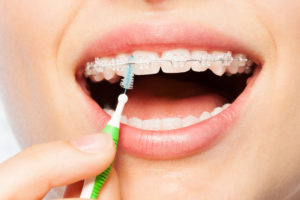
While similar to managing our oral health, maintaining our braces has a few extra steps. To maintain good oral health with braces, it’s important to adopt good oral hygiene throughout the entire process. Brushing after every meal is one of the most important but most overlooked steps in maintaining good oral health. When eating, food particles get stuck in between our teeth and our braces, which can cause staining and bacterial backup between our teeth. Using a regular soft brush in an up-and-down motion on each tooth will do the trick. Secondly, use threadable floss or a floss threader. These tools allow you to get between each tooth and underneath the wires to clean out any food that may be trapped there. Insert the threader between two teeth and move back and forth until the food is released. Lastly, use a proxabrush, or a “Christmas tree brush.” Place the proxabrush between two brackets, below the archwire, and brush up and down. Like the threader, this will also help loosen up any food that may be stuck between your teeth.
A great way to ensure that your braces don’t break and that you don’t get unwanted gunk stuck in them is to watch what foods you’re eating. Foods that are hard, sticky, or high in sugar should be avoided. Eating food that is high in sugar can cause cavities when wearing braces, which can lead to more dental work that you would need to have done. Furthermore, patients with braces should limit between meal snacks and avoid food that could bend the wires, such as caramel, nuts, chewing gum, ice, or popcorn.
When To See An Orthodontist
Now that we understand more about the importance of our oral health, plus the different types of braces, when should we make an appointment with an orthodontist? Many times, we only schedule a time to see an orthodontist whenever our teeth are crooked and we want them straightened. But there are other factors that influence when we should start thinking about getting in to see the doctor:
- Jaws that shift, make sounds, protrude, or are recessed
- Speech difficulty
- Biting the cheek or biting into the roof of the mouth
- Facial imbalance or asymmetry (features out of proportion to the rest of the face)
- Inability to comfortably close lips
- Grinding or clenching of teeth
As mentioned earlier, these are signs that your oral health might not be up to par like it should be. Meeting with your orthodontist and discussing these issues will help them better treat you with one of the four types of braces that we discussed previously. The sooner you get in to see your orthodontist, the sooner any pain or discomfort can be evaluated, treated, and extinguished.
Meet Your New Year’s Resolutions With Our Help!
Belmar Orthodontics can help you on your path towards having a straighter smiles and better oral health. With reputable orthodontists, manageable treatment plans, and services for children and adults, we can help you get the smile that you deserve! Call (303) 225-9016!
Braces: How Are They Made?

You may wonder what the differences are between metal, ceramic, and lingual braces and how they compare to Invisalign treatment. All are a bit different and they are both made and worn differently. Braces are made from various materials and designed specifically for your mouth.
Metal Braces and Your Teeth
You’ve likely seen someone wearing metal braces and you know that they make your teeth straighter. But how? It takes a bit of science and the right orthodontic appliance to make that beautiful smile happen. With the most common type of braces—metal braces—you have a stainless steel material that is shaped into specific orthodontic parts that will all go together in your mouth. Often those parts are molded and shaped in a special lab that then ships those parts to orthodontists.
Labs will even do custom-made brackets and wires for patients when the need arises. However, most braces have a specific design like metal braces do. Metal braces have several parts that include:
- Brackets: These stainless steel pieces are those little squares bonded to the middle of each tooth. We use a special bonding glue that will stay on your teeth for the entire duration of your treatment, but will come off easily with the right orthodontic material. Your brackets are small anchors that hold a wire in place. They will have tiny rubber elastics placed around them to protect your teeth and prevent stuck food.
- Archwire: This metal wire will pass through the brackets on each tooth, all the way to the back of your mouth. Many patients have a bracket that wraps around the back molar that stabilizes this archwire. The wire will follow the curve of your jaws in an elongated have circle. When a thicker archwire is placed or when this archwire is adjusted, it can help move the teeth into place because of the force placed on the brackets.
- Ligature Elastics: These are the rubber elastics we mentioned. The elastics are what keep the archwire sturdy so it can straighten your teeth.
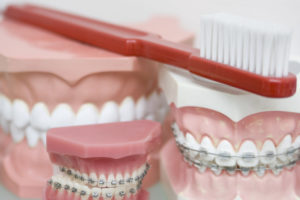
How Teeth Straighten
Your archwire will be adjusted very slightly at your orthodontic appointments every 4-6 weeks. That slight adjustment may seem very small, but it’s what your mouth needs to make a true, straightening change. The appliance is not the only thing changing your teeth into a straighter position. Your teeth are the hardest substance in the body and can even be harder than many metals. Straightening them would seem very difficult, when it’s not. It simply takes time.
Your teeth can take a ton of force from chewing, biting, eating, talking and other actions because they are rooted into your jawbone. However, the jawbone is much weaker than the teeth are. So why doesn’t your jawbone get breaks in it when you chew hard things? You have something called the periodontic ligament that is around every tooth root as it goes into your jaw bone. All those ligaments are shock absorbers for your jaws when you chew, minimizing the force your jawbones take. These are key to straightening the teeth.
When orthodontic appliances are on the teeth, they will apply a very slight pressure to your teeth and to the periodontic ligaments that surround them. When that pressure is constantly there, your body will produce acids in the jawbone area that will break down tiny parts around the teeth. With new space created, the teeth can shift. Your body will naturally deposit more minerals in areas that have changed to strengthen the jawbone once more. Over time, your jaw is literally breaking itself down on a microscopic level and then rebuilding itself. That is why orthodontic treatment takes months. However, the result is worth it.
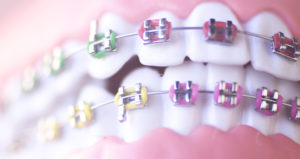
Ceramic and Lingual Braces
Ceramic and lingual braces are very similar to traditional metal braces, but are made a bit differently. Lingual braces are also a metal braces type, and most types are made from stainless steel in a lab. There can be other types of metal used or a combination of metals. These braces will have brackets and wires just like traditional metal braces, except that they will be placed on the back of a patient’s teeth.
Because of placement, children are not usually candidates for lingual braces because of the size of the teeth. Dental impressions of the back of the teeth are made so that metal coverings can be made for the tooth backs, which is a bit different than traditional metal braces. More anchoring is needed with lingual braces, and this is how it is done. The metal material will cover the entire tooth back with a bracket in the center of the tooth, and each is placed individually when a patient gets their appliance. The archwire works the same as other braces.
Ceramic braces are very similar to metal braces in their design and how they work. However, they are made from ceramic material, which is naturally white already. This makes the braces blend in with the teeth more, and the metal can even be frosted to blend in with whiter teeth.
Invisalign: Customized to the Patient
Invisalign treatment is an orthodontic option that is vastly different than your other options. The most noticeable difference is that there is no metal or ceramic material in your appliance. A patient will have digital images taken of their mouth. With that image, custom aligners are made that a patient will switch out each week. These are a type of plastic material patented by the Invisalign company. It’s a strong enough plastic to cause the same type of shifting you want your teeth to do. Aligners fit snug in the mouth as they are custom made, are switched out each week, and must be worn 20-22 hours of the day. If you are interested in any of these types of braces or want to see how the braces are put on a patient, call Belmar Orthodontics today at (303) 225-9016 with your questions!
Dressing Up Your Smile During the Holidays

The holidays are here, which means parties, dinners, photo opportunities and more. Now is a great time to make your smile shine, and you can do that through orthodontic treatment. If you’re smile is lack-luster, consider our four orthodontic options that can help you have a straighter smile. For those already with braces, you can dress up your brackets with bright colors to reflect the season. Use these tips for getting a more beautiful smile with braces and having that show in your holiday snapshots this year!
Dress Up Your Smile with Orthodontics
The higher number of holidays during the winter season is believed to be because of the many pagan festivals that surrounded the Winter Solstice many years ago. That solstice happens in the third week of december, where there is Christmas, Hanukkah, New Years and other holidays all happening. With all those holidays and the gatherings that come with them, it’s likely to mean many opportunities for photos and showing off your smile. You want that smile to impress.
Studies show that people that straighten their smiles often feel more confident than those who don’t. That confidence can be visible even while you are currently getting orthodontic treatment. Straight teeth are so important to people that 87% of people are willing to forego something they want for a year or more to be able to get braces. If you have braces, not only is it something to be proud of, but something to be admired. If you don’t have braces, getting them is a great way to give yourself an amazing gift just in time for the holidays.

Your Treatment Options
In the past, metal braces were your only option. However, you have many cool options today that you can gift yourself such as:
- Traditional Metal Braces – These are the classic metal bracket and wire option that is most commonly chosen by patients. Patients who chose this option come in to have their wires tightened at each appointment.
- Ceramic Braces – These braces are a close cousin to metal braces. They have the same bracket and wire design of metal braces, except that they are made out of ceramic material. This helps decrease demineralization during your orthodontic treatment. Ceramic material is also naturally white, helping these braces to blend in with your teeth more than metal would.
- Lingual Braces – These are metal braces that are placed on the back of your teeth. Instead of just a square bracket, the metal must be custom-made to the shape of the back of your teeth. This is a discrete option that adults and teens love.
- Invisalign Treatment – This is the most invisible option available to our patients. Invisalign is a series of transparent aligners that you wear at night and throughout the day. You can remove them for eating, playing sports, cleaning your teeth and more.
If You Already Have Braces
Maybe you already have braces. You can still make your smile wow in pictures by taking care of your smile. If you have metal or ceramic braces, our patients love to get colored bands that reflect the colors of the holidays. You can make your bands green and red for Christmas, blue and white for winter or any color you would like. Colorful bracket bands are just one way you can dress up your smile.
If you already have braces, then you have already started on your journey to a better smile. Orthodontic treatment can correct mild to severe issues with bite and alignment, and can help correct speech impediments. It can bring the teeth and jaws into proper position, reducing your risk for oral health diseases such as tooth decay and gum disease. Straighter teeth are teeth that are easier to clean and less likely to have breaks and fractures from uneven mouth pressure.
However, if you want your smile to dazzle in photos and at holiday get-togethers, you have to take care of it. The best way to do that is by brushing and flossing your teeth. Those two simple steps should be dones several times a day to keep your brackets clean and your teeth polished. Patients should brush 3 times a day or more to dislodge food and to clean the teeth after meals. Flossing should be done 1-2 times a day. Even though it takes a bit longer to do, don’t skip this step! If you do, you miss cleaning 40% of your tooth surfaces that can leave them open to decay, erosion and staining. Those are not things you want in a holiday photo.

Better Health for the New Year
The end of the year is a time to start making goals for the new year. One of those goals can be focused around having better health in the new year. Many people don’t realize just how connected oral health is with overall health. Countless chronic conditions can become more mild or they can intensify depending on how well you are taking care of your oral health. For example, if you have diabetes, not taking care of your teeth and gums can lead to oral infections that are really hard to battle because you have diabetes. Your body is less able to fight those infections and the infections can spread, worsening your condition.
However, if you do the basics of brushing your teeth, flossing and visiting your dentist and orthodontist like you should, you can keep your oral health in great shape. That makes it so your smile is amazing when your braces come off instead of damaged or decayed. To get some tips for taking care of your braces or for starting on an orthodontic plan, call Belmar Orthodontics today at (303) 225-9016!
Incognito Lingual Braces Vs. Traditional Metal Braces
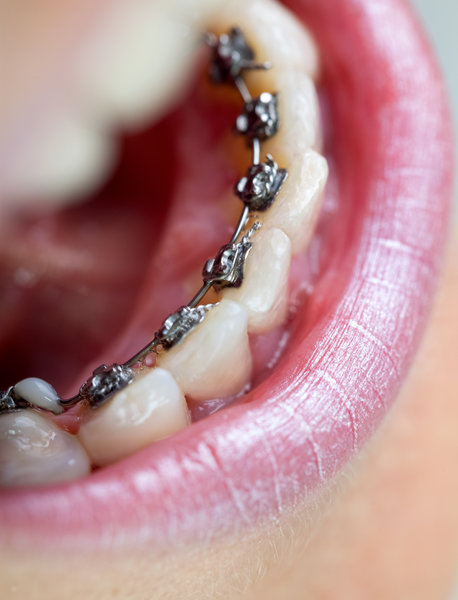
Young woman with lingual braces
There are many services we offer when it comes to straightening the teeth, including Incognito lingual braces and traditional metal braces. These two options are very similar, however, lingual braces are made slightly different than traditional metal braces because of where and how they are worn. Both will give you amazing straightening results and both are services we provide. What choice is right for you? Which is best for your budget and for your time? We can help you know the difference between Incognito lingual braces and traditional metal brackets and help you choose which option you’ll love the most. As always, with professional orthodontic care through Belmar Orthodontics, you can be sure you receive quality straightening power no matter what option you choose.
Investing In Braces
When you invest your time in braces, you are making an investment for the rest of your life. Your smile is one of the first physical features others see. Is that smile making an impression? We want all of our patients to have beautiful, healthy smiles. Why? Beautiful smiles are quite attractive to others. In studies, those with a straighter, more beautiful smile are seen as more attractive, trustworthy, confident and successful. Straighter smiles tell others that you take care of yourself.
When it comes to your health, a straighter smile can also help reduce your risk for tooth decay and gum disease. This is because the teeth are aligned and much easier to clean, especially in between the teeth. Plaque has a harder time staying stuck on the teeth and causing problems when the teeth are easier to clean. So when it comes to both aesthetic and health reasons, braces can really change your life! There are many options when it comes to choosing the right braces for you. Some of the most popular options in orthodontics are traditional metal braces and Incognito lingual braces.
Traditional Metal Braces
These are the braces you probably imagine when you think of braces. They are traditional because they’ve been around for decades and are proven to straighten your teeth effectively. Traditional metal braces are worn on the front of the teeth. In times past, the term “metal mouth” was a term some used to describe those who had these braces. However, studies have shown that braces have become a luxury in modern times.
Traditional metal braces are more popular than ever, especially among teenagers. Metal braces have also taken on a much smaller and sleeker design so you no longer have a mouth so full of metal. The best part about traditional metal braces (besides how well they work) is that they are also the least expensive option when it comes to orthodontic care. You can also dress up these braces with bright bands of color and express yourself the way you want.
Incognito Lingual Braces
Love the idea of metal braces but don’t exactly love how noticeable they are? We are excited to be able to offer our patients an alternative to traditional metal braces: hidden lingual braces. There are about 4.5 million Americans that currently wear braces. Of those, 25% are adults. The majority of the rest of braces wearers are teenagers. It is common for some adults and teenagers to avoid orthodontic treatment because they find metal braces to be unattractive or distracting. However, most people love to have straighter teeth. The solution? Incognito lingual braces!
With lingual braces, you can achieve the same results as traditional braces with a hidden treatment apparatus on the tongue-side of your teeth (by the tongue and palate). This is why they are referred to as “incognito” braces—they stay hidden (or incognito) as you straighten. We will take an impression of your teeth and make customized brackets fit perfectly to you. Lingual braces work much like traditional metal braces by slowly shifting the teeth into proper alignment. Unlike metal braces, each tooth must have its own installment of brackets and wires, as the lingual braces are shaped to each tooth back. Special training and technical expertise are needed to install these braces, and they do cost a bit more than traditional metal braces. However, you receive the trade-off of these braces being so undetectable.
Other Braces
There are more options than just traditional metal braces and Incognito lingual braces. We also offer:
- Invisalign – For those seeking an option that goes beyond Incognito braces, they can invest in Invisalign. This is a series of transparent aligners that are replaced every 1-2 weeks. They are virtually invisible and can be removed for eating, drinking, cleaning and sports.
- Ceramic Braces – Made from ceramic material, these white braces seek to have the functionality of traditional metal braces while blending into the teeth. Both the brackets and the wires can be made white so the braces are hard to see against the teeth.
Getting Your Braces
When it comes to receiving your braces, we want to give you options so that you truly enjoy your braces experience. Both traditional metal braces and lingual braces will work hard to straighten your smile. The dentists at Belmar Orthodontics have the expertise, training and experience to install both traditional metal braces or Incognito lingual braces to your smile. To start your orthodontic treatment with metal or lingual braces today, call our Belmar Orthodontics office today at (303) 225-9016!
Color, Color, Color! Make a Statement with Clear Braces
Young patients love the versatility of clear braces paired with colorful elastic ties. Clear braces provide something no other treatment option can; color REALLY stands out when you want it to. Kids love to stand out and love the creativity that they can express with their smile during orthodontic treatment. We want braces to be fun. Clear braces with colored elastics brings the fun in! Our Belmar Orthodontics staff is dedicated to helping you enjoy the smile transformation process. We want you smiling before, during, and after treatment! Clear braces offer you that confidence-boosting option.
Give Me Some Color, Please!
Kids love to choose color elastic ties (ligatures) for their braces that correspond with their favorite sports team, their school, or the holidays. Not sure which color combination to choose? Not to worry! Dr. Hardy and our friendly Lakewood staff can help you come up with a color combination that you will love to share! When it is time for your next adjustment you can continue the color combination or swap out for a new one! Or, go clear! Some of our adult patients like to opt for a more discreet look so they will choose clear elastics that make their orthodontic treatment almost invisible.
Can Elastic Bands Stain?
Not all industry elastic bands provide you with stain resistance, but at Belmar Orthodontics we use top-of-the-line elastic bands fabricated by 3M Technologies. The National Institutes of Health published the findings of a study of the stain resistance of 5 different types of bands, and 3M elastics were shown to provide more resistance to staining than the competition. Adhering to proper oral hygiene with your braces and avoiding foods that stain will help clear-colored bands retain their desired color.
Low-Profile Brackets with Increased Comfort
Another advantage that clear braces have over traditional is their size and shape. Ceramic brackets sit lower on the teeth and have rounded edges. Because the bracket doesn’t sit as high on the tooth, they are less noticeable. The rounded edges also protect the soft tissues of your mouth from irritation or sores.
Your Time with Braces is Temporary–Take Advantage of It!
Although you may think your time with braces is going to feel like forever, you will be surprised how fast your treatment passes. Before you know it, this chapter of your life will be over and so will your time with braces. Make the most of it! Look for ways to make your smile unique and to have fun with it! If you take care of your teeth after your orthodontic treatment, and wear your retainers, this will be the only time you will need braces. Although at times they can challenge your patience, orthodontic braces today really are amazing technology that YOU get to benefit from! Braces of the past were bulky, uncomfortable and had longer treatment times. The braces of today are stylish, more effective, less obtrusive and can really help boost your confidence.
Why Choose Belmar Orthodontics for Your Orthodontic Care?
As active members of the American Dental Association and the American Association of Orthodontists, Dr. Hardy and our entire team of dental professionals are dedicated to creating a relaxed, personalized experience for our Belmar Orthodontics patients. We invite all our patients–both young and old–to actively participate in their care by asking lots of questions and expressing any concerns that might arise might during treatment. Educated patients know what they want, know what it takes to get it, and know better how to retain it when they are done. We offer many flexible treatment options to help you have the experience you want during and after your time with us.
Schedule a Clear Braces Consultation to Learn More
If you are considering ceramic clear braces, but still aren’t sure if this bracket system is for you, schedule a free consultation so we can discuss the pros and cons. Clear ceramic braces by 3M Technologies are rising in popularity because of their ability to offer you the pros of traditional braces without the cons of Invisalign, and with a much more aesthetic approach. Call today to learn all the things you can do with clear braces to make your treatment unique, fun and effective. You can make an appointment by contacting our office at 303.225.9016. We are excited to meet you and help you reach your smile goals!
The Advantages of Clear Ceramic Braces
 Clear ceramic braces replace the traditional metal bracket system of the past with the power and beauty of clear ceramics. Clear braces are just that (clear) making your braces less noticeable to others and with a material that is kinder to the enamel of your teeth. Clear braces are often selected by adults and older teenagers that don’t want the visibility of traditional braces, but like the convenience of a fixed system unlike Invisalign. Learning about the advantages of this bracket system can help you determine if they are for you.
Clear ceramic braces replace the traditional metal bracket system of the past with the power and beauty of clear ceramics. Clear braces are just that (clear) making your braces less noticeable to others and with a material that is kinder to the enamel of your teeth. Clear braces are often selected by adults and older teenagers that don’t want the visibility of traditional braces, but like the convenience of a fixed system unlike Invisalign. Learning about the advantages of this bracket system can help you determine if they are for you.
They’re Clear!
No one can argue with the clear, aesthetic design ceramic braces achieve. The translucent braces blend in naturally with your teeth making them much less noticeable than other types of braces. Their low-profile design also aids in rendering them virtually undetectable. For certain professionals this clear design is a necessity! Clear ceramic braces were designed for patients of any age who are looking for the confidence and the freedom to smile in any circumstance without worrying that their braces will distract or garner too much unwanted attention.
Add Colored Bands to Make a Statement
Our younger patients often have a different outlook than our young professionals or adult patients–they want color! They want their braces to pop and make a statement. When colored bands are placed on clear ceramic brackets they really enhance the bracket and create an impressive “wow” factor unlike traditional metal brackets. Kids like to wear their local school’s colors or to dress their teeth to match a holiday. Ceramic brackets give them an option to have some fun!
Reliability, Strength, Comfort and Small Bracket Design
Ceramic braces differ from metal braces because they offer a smaller bracket design which takes up less space on the front of your tooth. Their innovative, fine-grained ceramic material is stronger than the competition making them less resistant to damage and more resilient during your treatment. They are also more resistant to staining and discoloration throughout the treatment process than their predecessors. Clarity™ ADVANCED Clear Ceramic Braces by 3M were designed with rounded corners to improve patient comfort and reduce irritation that occurs from brackets with rougher edges that come in contact with the soft tissues of your mouth.
Easy Removal After Treatment with High-Tech Debonding
One of the questions many patients fail to ask when they are researching the different kinds of braces, and their associated advantages and disadvantages, is how easily are they removed after treatment? Some bracket bonding agents can be very harsh on your teeth and can take part of your tooth enamel during the removal process. You don’t have to worry about this happening with Clarity™ ADVANCED Ceramic Braces by 3M. Dr. Hardy abides by certain standards of care for his patients to ensure that they only receive the best of the best.
Clear Ceramic Braces Safeguard Teeth
It should be the goal of each dental practitioner to utilize the best material for patient treatment. Dr. Hardy not only believes in this principle, but makes it happen. Studies comparing the different materials designed exclusively for the bonding of brackets and attachments have been conducted to ensure that the highest bond strength is matched with the least amount of change to the tooth enamel upon application, during treatment, and at removal. Demineralization around the bracket is an undesired side effect of some orthodontic treatment materials and methods. 3M Technologies went a step further with their innovation to create a top-of-the-line bonding agent that prevent this demineralization around the bracket. Clarity™ ADVANCED Ceramic Braces do all this without sacrificing the superior, adhesive strength you should expect so brackets stay strong and fixed during the treatment process.
Created by a Company You Can Trust
Trusting the outcome of your orthodontic experience is dependent on the skills of your orthodontist and staff, but also on the products that they choose to use for your treatment. You can trust that your decision to use ceramic clear braces, designed and fabricated by 3M Technologies, will give you the results you deserve and expect. They are a recognized, industry giant with many accolades to their achievements in innovation and science.
Schedule a Clear Braces Consultation to Learn More
If you are in need of orthodontic treatment, but are worried about how the appliance may impact your appearance, you are not alone. Patients desire to have both a product that is innovative and effective, but also visually appealing. The dental industry has listened to this request and has answered by bringing you the innovation of clear ceramic braces. Clear ceramic braces by 3M Technologies offer you all the pros of traditional braces without the cons of Invisalign, and with a much more aesthetic approach. The best way to find out if you are a candidate for clear ceramic braces–and to learn more–is to schedule an appointment for an in-office consultation. Make an appointment by contacting our office today at 303.225.9016. We are excited to meet you and help you reach your smile goals!


